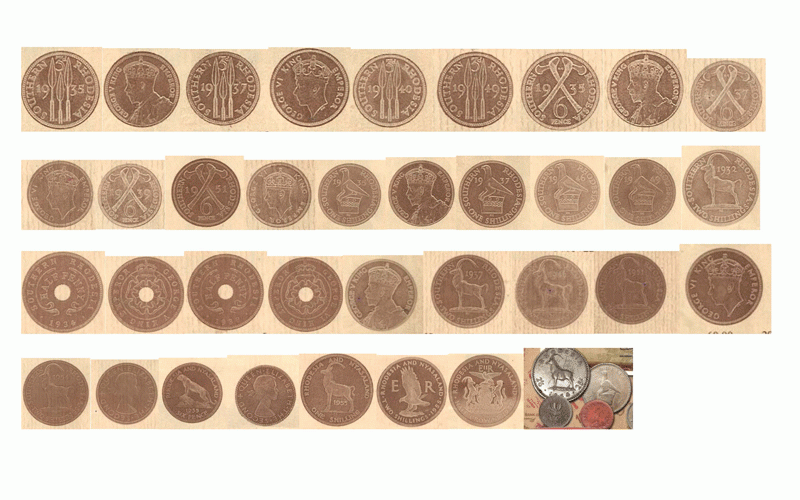
IN 1936 King George the Fifth died and silver coins minted thereafter bore, for the obverse impression, the crowned effigy of His Majesty King George the Sixth consisting of head looking to the left and the inscription on all coins was changed to ‘George VI, King –Emperor’.
No coins were minted during the short reign of King Edward the Eighth in 1936.
With the coming into operation of the ‘Coinage and Currency Act 1938, on January 3 1939, all previous coinage legislation was repealed.
The new Act provided for the minting of silver coins of the denominations 3d.to 2/-. And cupronickel and bronze coins of the denominations of 1d. and 1/2d.
In 1942, owing to the Second World Wartime shortage of nickel for coinage purposes, as a result of a huge demand for this metal for the manufacture of munitions, the composition of the 1d. and the 1/2d. denominations was changed.
In 1944 , owing to a world shortage of silver for coinage purposes and the possibility of future heavy liability for replacement of such silver bullion as might be acquired for such purposes under war- time Lend-Lease terms, the fitness of Southern Rhodesia silver coins was reduced from .925 to .500 (50% silver,40%copper,5%nickel and 5% zinc).
In 1947, the price of silver went up and it became very difficult to maintain the standards of metal representations in coins. Eventually the coins of 2/6d,2/-,1/-,6d and 3d denominations were debased from silver to cupro-nickel and a policy of withdrawal of the silver coins from circulation for the recovery of the silver content was embarked upon.
In 1948, as a result of the passing of independence of India Act, by the British Parliament, whereby His Majesty ceased to hold the title” Emperor of India”, the word emperor was removed from the flipside design of the Southern Rhodesia coins and the inscriptions on all coins became “King George The Sixth”. On the reverse side of the half –crown the symbols ‘GVIR’ replaced ‘GVIRF’.
- The prime ministers who served under Queen Elizabeth II
- EPL postpones weekend fixtures following death of Queen
- Commonwealth Fellow goes down memory lane
- Queen Elizabeth: monarch who had to adjust to the shift from Empire to Commonwealth
Keep Reading
The new design was made by Percy Metcalf C V O the original artist.
The accession of Queen Elizabeth II to the throne in 1952 necessitated a change to the Southern Rhodesian coins. The obverse impression on the cupro-nickel coins became that of the uncrowned effigy of Her Majesty Queen Elizabeth The Second, consisting of head looking to the right, and the inscription on all coins became ”Queen Elizabeth The Second” the symbols” GVIR” on the reverse side of the half - crown became “E II R”.
The obverse design was done by Mary Gillick, the sculptress. It showed the Queen wearing a laurel wreath tied at the back, with a flowing ribbon above two curls lying over the nape of the neck.
This followed the old British tradition of an uncrowned effigy of the monarch upon British-a tradition that was unbroken from the beginning of the reign of Charles II until the Victorian florin of 1848.
The one and only minting of Southern Rhodesia cupro-nickel coins bearing the Queen’s effigy was dated 1954, as were the only Southern Rhodesia pennies and half-pennies of the Elizabeth II reign.
The edges of all Southern Rhodesian coins of the 2/6d, 2/-,1/-,and 6d denominations were milled but those of the 3d,1d and 1/2d denominations were plain.
In 1953, the only minting of Southern Rhodesian crown pieces was issued to commemorate the centenary of the birth of Cecil John Rhodes, the Colony’s Founder, in 1853.
The coins were of .500 silver and the issue comprised 123 500 ordinary pieces for circulation ’proof’ pieces in presentation cases.
The obverse design of the crown piece comprised the uncrowned effigy of Her Majesty Queen Elizabeth II, consisting of head looking to the right, with the inscription’ Queen Elizabeth the second’.
The reverse design consisted of Cecil John Rhodes, three quarter face, in a circle above three shields bearing the Arms of Southern Rhodesia, Northern Rhodesia and Nyasaland, resting upon and enclosed by two sprigs of laurel entwined by a ribbon bearing the name ‘Cecil Rhodes’ and dated 1853-1902.
The edge of the crown piece bore the inscription “1853 out of vision came reality 1953” in incuse lettering.
A peculiarity of these coins was that on some of them the inscription on them no attempt was made to ensure that all the coins were fed into the machine with the some side upwards.
AII Southern Rhodesia coins were minted by Royal mint, London.
Southern Rhodesia coin of the denominations 2/d.to 6d. ceased to be legal tender on June 1 1965 and in terms of Rhodesia Government Notice No. 96 of 1968, the Reserve Bank of Rhodesia was not required, with effect from February 16 1968 to make payment for Southern Rhodesia coins of the denominations of 2/6d,2/-,1/-,and 6d but might, in its sole discretion, continue to make payment on such terms and conditions as might deem fit.
In terms of Rhodesia Government Notice No 742 of 1972 Southern Rhodesia 1d and 1/2dcoins were demonetised on the 1st January 1973.
The Federation coins
The Federation necessitated a complete change of coinage design. The first minting of Federal coin, which included 2000 sets of ‘proof’ coins in presentation cases, was dated 1955.These new coins were cupro-nickel 2/6d, 2/-,1/-,6d and 3d .The 1d,1/2d were of bronze.
The proof coins of the 2/6d to 3d denominations were of .500 silver and those of 1/d. and 1/2d were of bronze. The 2/6d ,2/-,1/- and 6d had milled edges but the edges of the 3d.,1d and 1/2d were plain.
The Federal coins all had for their obverse impression the uncrowned effigy of Her Majesty Queen Elizabeth the Second consisting of head looking to the right, with the inscription ‘Queen Elizabeth the Second’.
For their reverse impressions the coins had, for the Half Crown; the coat of arms of the Federation of Rhodesia and Nyasaland surmounted by the Royal Cypher ‘E II R’, in addition to the words ‘Rhodesia and Nyasaland’.
The Florin had a Fish Eagle in flight, with a fish in its talons between the letters ‘E.R’
The Shilling had a sable antelope (Hippotragus niger.
The Sixpence had a leopard.
The Threepence had a Flame Lilly (Gloriosa Superba)
The two denominations of Federal bronze coins, which were perforated in the centre had, for the reverse impression, a simple arrangement of the name of the Federation, the date of the year and, within ornamental scrolls, the denominations, but the obverse impressions were different.
For the Penny, it had two elephants rampant facing each other, with between the upstretched trunks, a crown and around, the inscription ’Queen Elizabeth the Second’.
The Half Penny had two giraffes facing each other, with, between the heads, a crown and around the inscription ’Queen Elizabeth the Second.’
The standard weights, compositions, diameters, thicknesses of the Federal coins were the same as those of the Southern Rhodesia cupro-nickel and bronze coins.
All Federal coins were minted by the Royal Mint, London.
Later, all Federal coins of the denominations 2/6d. to 6d. ceased to be legal tender on June 1 1965, and in terms of Rhodesia Government Notice No.96 of 1968, the Reserve Bank of Rhodesia was not required, with effect from February 16 1968 to make payment for Federal coins of the denominations of 2/6d. 2/-,1/- and 6d. but might, in its sole discretion, continue to make payment on such terms and conditions as it might deem fit.
Therefore, in terms of Rhodesia Government Notice No.742 of 1972, Federal 1d and 1/2d coins were demonetised on January 1 1973.
Muzorori is a researcher and writer.






